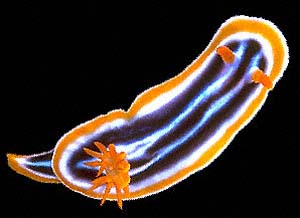
Chromodoris magnifica
(Quoy & Gaimard, 1832)
Order: NUDIBRANCHIA
Suborder: DORIDINA
Family: Chromodorididae
DISTRIBUTION
Known only from Indonesia, Papua New Guinea and eastern Australia. Also the Philippines (in messages below).
PHOTO
Heron Island, Great Barrier Reef, Queensland, September 1983.
Photo: Bill Rudman.
References:
• Quoy, J.R. & Gaimard, J.P. (1832). Voyage de decouvertes de L'Astrolabe pendant les annees 1826-1827-1828-1829, sous le commandement de M.J. Dumont D'Urville, Zoologie, 2: 1-686.
• Rudman, W.B. (1982) The Chromodorididae (Opisthobranchia: Mollusca) of the Indo-West Pacific: Chromodoris quadricolor, C. lineolata and Hypselodoris nigrolineata
colour groups. Zoological Journal of the Linnean Society 76: 183-241.
Rudman, W.B., 1998 (April 8) Chromodoris magnifica (Quoy & Gaimard, 1832). [In] Sea Slug Forum. Australian Museum, Sydney. Available from http://www.seaslugforum.net/find/chrmag
Related messages
Chromodoris magnifica - feeding record
March 12, 2010
From: Bill Rudman

Ed Dixon recenty sent me a note to say he had posted some new sets of pics of South Georgia on his Flickr site:
http://www.flickr.com/photos/efdixon/sets/72157623579199462/
http://www.flickr.com/photos/efdixon/sets/72157623454735811/
Although they don't include nudibranchs they are a stunning collection of wildlife and scenic shots from this remote southern island. After a look at South Georgia, I went looking at other of his folders and found this interesting shot of Chromodoris magnifica feeding, which Ed has given me permission to post on the Forum.
Locality: Wakatobi, Sulawesi, Indonesia, Banda Sea, 31 August 2007. Photographer: Edward F Dixon.
I am pretty sure this is the dysideid sponge Lamellodysidea herbacea which is also fed on by the similarly coloured Chromodoris lineolata [see message #19136]. Most species of Chromodoris feed on Dendroceratid sponges of the family Darwinellidea but there are a group of species, mainly with black longitudinal lines down their mantle which feed on an odd assortment of sponges which appear to be linked by a special chemical produced by these sponges called latrunculin. A commonly photographed example is C. quadricolor which feeds on the bright orange Negombata magnifica. On the Forum we have examples of it also feeding on species of thorectid sponges [see message #20150 where I also discuss the chemical link]. A few of these black-lined species, such as C. lineolata, also feed on some Dictyoceratid sponges of the family Dysideidae. Like C. quadricolor, records on the Forum show that C. magnifica also feeds on orange species of Negombata. It is great to get a record of it also feeding on a quite unrelated species of Lamellodysidea.
Thanks Ed,
Bill Rudman
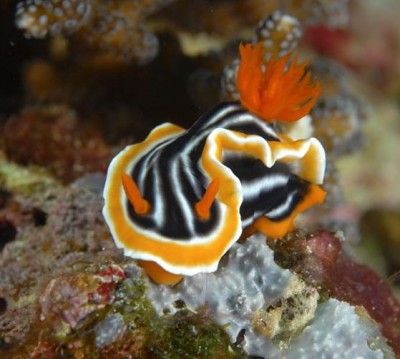
Photo: Edward F Dixon.
Chromodoris magnifica from the Philippines
December 7, 2009
From: Mónica Alonso
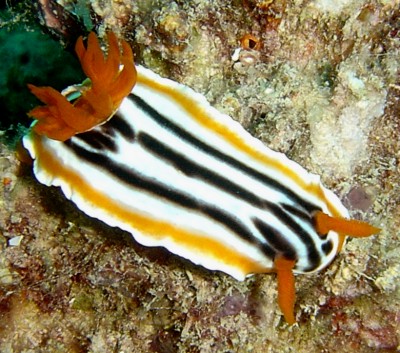
Hello.
Again I send a specimen of sea slug for you to help me to classfy.
Locality: Moalboal, Cebú, 10-15 m, Philippines, Philippines Sea, 12 April 2006. Length: 2-3 cm. Photographer: Alfredo Rizo.
I think it is Chromodoris strigata.
Thank you.
Mónica Alonso
monicaalonso091170@hotmail.com
Alonso, M. , 2009 (Dec 7) Chromodoris magnifica from the Philippines. [Message in] Sea Slug Forum. Australian Museum, Sydney. Available from http://www.seaslugforum.net/find/22930Dear Mónica,
This is Chromodoris magnifica. The black-lined species of Chromodoris are sometimes difficult to distinguish from one another but Chromodoris magnifica is quite easy to determine because the orange band around the mantle is some distance from the edge as we can see clearly in your animals. if you look at earlier messages you will see it is quite variable in colour but always the orange band is sub-marginal.
Best wishes,
Bill Rudman
Chromodoris magnifica ? and egg ribbon
February 13, 2008
From: Mirjam Broos
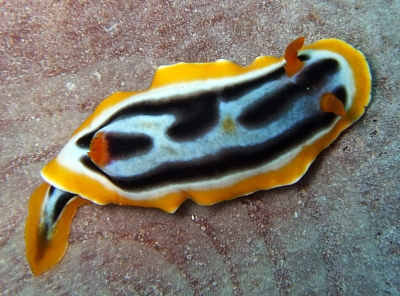
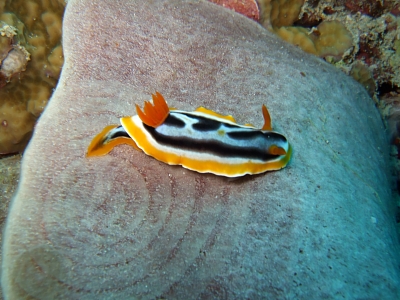
Bill,
It must be boring, but here is another blue Chromodoris [see messages #21278; #21279]. Is this C. sp 24? I noticed the small yellow dots, but don't know if that is important to recognize the specy?
Locality: Menjangan island, Pos 1, Bali, Indonesia, Indian ocean, 7 april 2007. Photographer: Geert Prast.
Looking forward to your answer.
Thanks again.
Mirjam
mirjam.broos@planet.nl
Broos, M., 2008 (Feb 13) Chromodoris magnifica ? and egg ribbon. [Message in] Sea Slug Forum. Australian Museum, Sydney. Available from http://www.seaslugforum.net/find/21280
Dear Mirjam,
I dont know what you mean by C. sp 24? as I don't list that many unknown chomodorids? If it's someone else's list you'll neeed to identify which list in future because there is no standard list of unidentified species.
This is probably the same animal as in Franca Wermuth's message [#20173] which I think may be C. magnifica, but not everyone agrees [see message #20490]. The yellowish spots you mention are the same as the orange-brown markings I mentioned in your last message [#21279] which for some reason are 'black' markings without the black pigmentation.
One thing you apparently haven't noticed is the flat egg ribbon the animal is on and which I suspect it may have deposited. All the black-lined species we know of lay this flattened egg ribbon so it's nice to get another example. The sponge it is on is possibly Petrosaspongia [see message #19222] but I can't see enough detail to be sure.
Best wishes,
Bill Rudman
Another 'blue' Chromodoris from Bali
February 13, 2008
From: Mirjam Broos
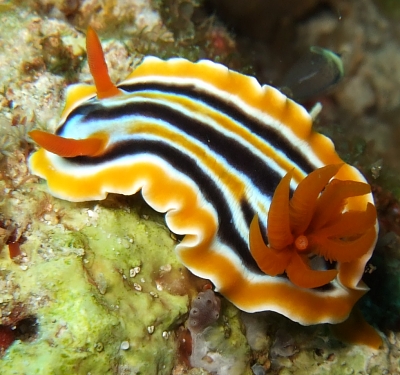
Hello Bill,
Following my last message [#21278] here is another 'blue' chromodorid. Because of the extra yellow lines I thought this could be Chromodoris strigata. Am I wrong?
Locality: Menjangan island, Pos 1, Bali, Indonesia, Indian ocean, 7 april 2007. Photographer: Geert Prast.
Mirjam
mirjam.broos@planet.nl
Broos, M., 2008 (Feb 13) Another 'blue' Chromodoris from Bali. [Message in] Sea Slug Forum. Australian Museum, Sydney. Available from http://www.seaslugforum.net/find/21279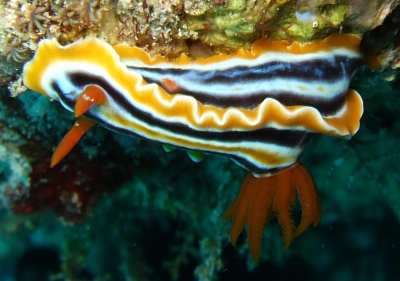
Dear Mirjam,
Some of these chromodorids are still a bit of a puzzle to us all but I am pretty sure this is a colour form ofChromodoris magnifica. The extra yellow-orange lines between the black lines are there to confuse us. This species can sometimes have secondary black lines and sometimes in these black-lined chromodorids the black pigment in these lines can be replaced with this brown -orange colour.
Best wishes,
Bill Rudman
Re: Chromodoris magnifica or C. annae
August 20, 2007
From: Nerida Wilson
Concerning message #20173:
Dear Bill and others,
I am pretty sure that the animal of Franca Wermuth represents something distinct. I came across it in south-east Sulawesi (one pictured by David Thompson, [#9801] as C. michaeli) where it occurs alongside C. magnifica and C. annae. Although they occur sympatrically, I never saw them physically occur together. There are also other pictures on the forum of this animal. Some from Bernard Picton ([#6114 lower photos] as C. magnifica) and from Lindsay Warren ([#45] as C. magnifica ).
Kind regards
Nerida
ngwilson@ucsd.edu
Wilson, N.G., 2007 (Aug 20) Re: Chromodoris magnifica or C. annae. [Message in] Sea Slug Forum. Australian Museum, Sydney. Available from http://www.seaslugforum.net/find/20490Thanks Nerida,
Another little job to add to the list. It certainly just doesn't squeeze easily into any of the likely species.
Best wishes,
Bill Rudman
Chromodoris magnifica or C. annae
August 16, 2007
From: Franca Wermuth
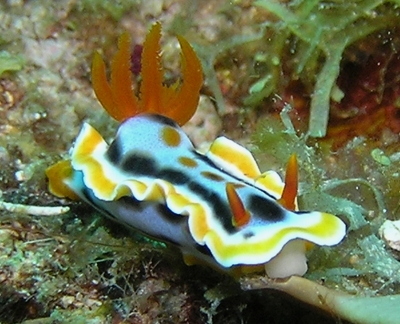
Dear Bill
I'm not so sure if this is Chromodoris magnifica or C. annae? Nearby there was a Chromodoris annae, so maybe it's the same species but different coloring?
Locality: Agtongo (Cabanbanan beach), Romblon, Philippines, South China Sea, 30 April 2007. Photographer: Franca Wermuth.
Thanks for your help!
Franca
franca.wermuth@gmx.ch
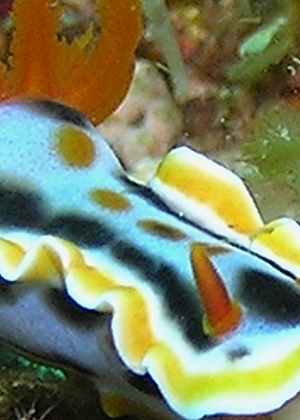
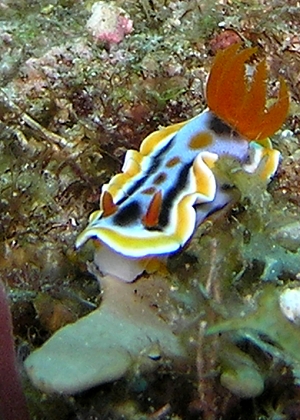
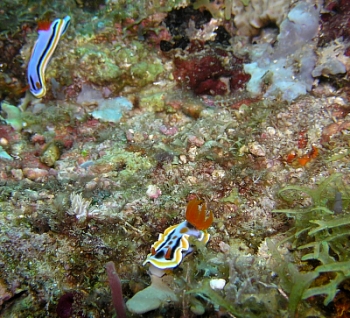
Dear Franca,
Both these species have a submarginal orange border and C. magnifica does seem to have more variability in colour than was originally thought, so your difficulty in identifying this animal is well justified. Looking closely at the blue region there appears to be the dark spotting or punctate pattern found in C. annae, but we have a photo of C. magnifica [#6114] with similar punctations but without the blue background. Also I have indentified some other animals with a blue background as C. magnifica, which is all a bit confusing. I am not sure what the full story is as yet but photos like yours are helping to sort out the problem. In general shape, C. magnifica has a broader mantle skirt but the tissue is thinner than in C. annae, which has a more elongate shape and with a narrower mantle skirt, much like the differences between the Indian Ocean pair, C. africana and C. quadricolor. I think it is best to identify your animal as C. magnifica, but I could be wrong.
It is interesting to see it apparently feeding on a greyish-white sponge, and in the general photo alongside, there seems to be quite a bit of that sponge around. The only good records we have of C. magnifica feeding is on red sponges of Negombata, although other species feeding on Negombata also feed on greyish thorectid sponges. Although there is not enough detail to positively identify the sponge, it is an intersting observation. Chromodoris annae definitely feeds on grey thorectids, so it would not be unusual to find both C. magnifica and C. annae together feeding on the same sponges, which I suspect is what is happening here.
Best wishes,
Bill Rudman
Chromodoris magnifica feeding record
March 20, 2007
From: Paul Osmond & Andre Seale
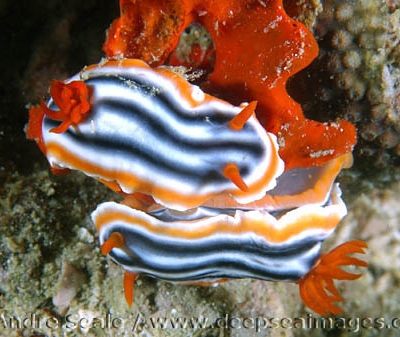
Hi Bill,
Sorry for the delay but here is the requested image of a pair of Chromodoris magnifica feeding on a bright red sponge on the Lapus Lapus dive site in Malapascua, The Philippines. The photographer, Andre Seale is a member of our stock library and you have permission to use this image for the Sea Slug Forum.
Locality: Lapus Lapus Island, Malapascua, Cebu, The Philippines. Fri September 9, 2005 Photographer: Andre Seale.
Enjoy,
Paul
www.deepseaimages.com
marriard@deepseaimages.com
Osmond, P. & Seale, A., 2007 (Mar 20) Chromodoris magnifica feeding record. [Message in] Sea Slug Forum. Australian Museum, Sydney. Available from http://www.seaslugforum.net/find/19696Dear Paul,
I don't mind waiting a while. I try to make time to scan the new offerings that appear on your website and others like it, so when I saw Andre's photo of C. magnifica I knew it had to be 'officially' noted as a feeding record of this species. It is almost certainly a species of the sponge genus Negombata, which as I mentioned recently [#19646], seems to be the sole food of C. magnifica.
Best wishes,
Bill Rudman
Re: Chromodoris magnifica? from the Philippines
March 13, 2007
From: Mike Krampf
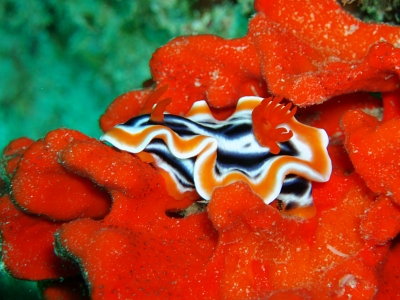
Concerning message #19593:
Thanks for the information of the Chromodoris magnifica. When you mentioned the C. magnifica feeding on a red sponge it reminded me of a picture I took recently. It wasn't obvious to me that this nudi was feeding but thought you might have some value for it.
Locality: Off Mataking Island, 50 ft, Sabah, Malaysia, Celebes Sea, 3 February 2007, Reef. Length: 4 cm. Photographer: Mike Krampf.
Thanks as always for the education and your time.
Mike
mtkrampf@yahoo.com
Krampf, Mike, 2007 (Mar 13) Re: Chromodoris magnifica? from the Philippines. [Message in] Sea Slug Forum. Australian Museum, Sydney. Available from http://www.seaslugforum.net/find/19646
Dear Mike,
Thanks very much for another piece in the puzzle. Although there is no definite evidence that it is feeding on this sponge, your photo is part of a growing amount of circumstantial evidence suggesting that the association of C. magnifica with this sponge is more than a chance occurrence. Although I am not an expert on these sponges, the shape and colour of the one in your photo would suggest it is a species of Negombata.
Best wishes,
Bill Rudman
Chromodoris magnifica? from the Philippines
March 12, 2007
From: Mike Krampf

I always struggle with naming these quadricolor nudi's. I'm calling this one a Chromodoris michaeli.
Locality: Dive Site - Ernie's Point, 45 ft, Puerto Galera, Philippines, South China Sea, 18 February 2007, Reef. Length: 3 cm. Photographer: Mike Krampf.
Your thoughts?
Cheers,
Mike
mtkrampf@yahoo.com
Krampf, M., 2007 (Mar 12) Chromodoris magnifica? from the Philippines. [Message in] Sea Slug Forum. Australian Museum, Sydney. Available from http://www.seaslugforum.net/find/19593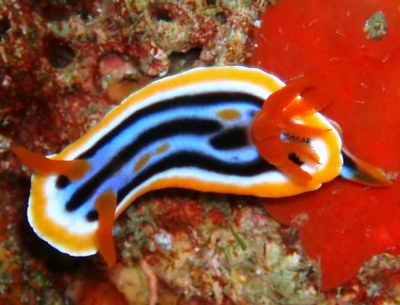
Dear Mike,
I am glad you have problems with this group of animals because the more photos of variations we get, the greater the likelihood we can resolve the puzzles surrounding this group. For example I am pretty sure this is a colour form of Chromodoris magnifica. I have been beginning to think that this species is a lot more variable than the 'typical' form with three black lines and a submarginal orange border. I am pretty sure that C. magnifica is the only one of this colour group which has a submarginal orange border rather than one right at the edge. It is also the only one in which the gills and rhinophores are often a very bright red rather than the same orange colour as the submarginal border. Unless there is a second species with a blue background, I think we have to start thinking of a blue background as being part of the variability of this species, along with mutliple black lines and occasional orange or brown lines.
Interestingly the red sponge your animal is on is most likely its food. Related to the red sponge, Negombata magnifica, on which C. quadricolor is usually found, we now have a number of records of C. magnifica on these red sponges. I should also say that it differs from C. michaeli in not having a punctate pattern on the blue region. If you look at photos of C. michaeli, C. dianae, C. annae and C. westraliensis the blue region of the mantle have what Gosliner & Behrens describe as 'a fine speckling of white'.
I think your photo will prove a valuable piece in the jigsaw puzzle
Best wishes,
Bill Rudman
Re: Chromodoris magnifica from Sulawesi
February 2, 2007
From: Mirjam Broos
Concerning message #19120:
Dear Bill,
Thanks for the identification. It's nice to learn more about sea slugs.I'm quickly becoming a kind of sea slug addict.
We didn't move the animal and found it right there on the grey sponge. Why do you think it is unhappy?
Greetings,
Mirjam Broos
mirjam.broos@planet.nl
Broos, M., 2007 (Feb 2) Re: Chromodoris magnifica from Sulawesi. [Message in] Sea Slug Forum. Australian Museum, Sydney. Available from http://www.seaslugforum.net/find/19322Dear Mirjam,
Thanks for getting back to me. I guess you get a feel for their 'body language' after studying them for many years but it looks as though I was wrong this time. Certainly the fully extended gills in your photo suggest the animal was relaxed, but often when you put an animal on an unfamiliar or 'uncomfortable' surface it will contract and the foot will not fully expand - which is what your animal seems to be doing. I need to know beacause I am interested in finding out which sponges the chromodorids feed on, and one method is to make a note of the various sponges each species is actually found on. Although witnessing feeding in process is the only 100% accurate method, finding a nudibranch consistently on one species of sponge is a useful way to get clues about possible food items. But for that to work I have to be sure that photos with a nudibranch on a potential food item are 'real'. I have nothing against 'posed' photos as sometimes it is not possible to take a photo unless you move an animal to a more convenient spot, but it can be misleading, so when I have a doubt, I think it is better to ask.
Best wishes,
Bill Rudman
Chromodoris magnifica from Sulawesi
January 26, 2007
From: Mirjam Broos
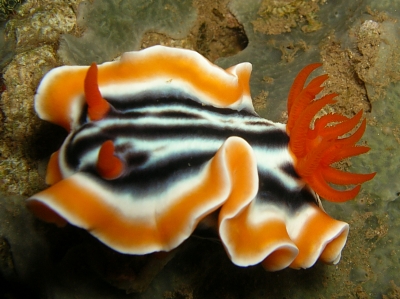
Hi Bill,
I have a hard time identifying the different species of Chromodoris. Is this C. quadricolor? We found it during a nightdive.
Locality: Paradise Jetty, Likupang, North Sulawesi, Indonesia, 07-10-2006. Photographer: Geert Prast.
Thanks again,
Mirjam Broos
mirjam.broos@planet.nl
Broos, M., 2007 (Jan 26) Chromodoris magnifica from Sulawesi. [Message in] Sea Slug Forum. Australian Museum, Sydney. Available from http://www.seaslugforum.net/find/19120Dear Mirjam,
This looks very similar to C. quadricolor, but that species has not been recorded from as far east as Sulawesi at present, and it differs in having four colours - hence its name. This is C. magnifica, a species which lacks any blue coloration, and in which the orange mantle border is a submarginal band not a marginal band.
Would you by any chance remember if you found this animal on the greyish sponge it is photographed on? It doesn't look that happy on the sponge and so I wondered if it had been moved there for a better photo. Why I need to check is that I am keen on building up information on the sponges these chromodorids are normally found on.
Best wishes,
Bill Rudman
Chromodoris magnifica feeding?
January 17, 2007
From: Paul Osmond

Hi Bill,
Found this Chromodoris magnifica on a coral reef head on the Aphol Dive site in Anilao, The Philippines in August of 2006. I was wondering whether the yellow sponge pictured is the food source for this species or just something it is just sitting on.
Locality: Aphol Dive Site, 15m, Anilao, The Philippines, 13 August 2006, patch coral reef. Length: 30mm. Photographer: Paul T Osmond.
I also have included an older image where the same species is on a grey sponge (and near a pink sponge) which is similar to another image I saw on the forum from Charles Rowe [#16851 ].
Enjoy,
Paul
Deep Sea Images
marriard@deepseaimages.com


Dear Paul,
Thanks for the photos. They well illustrate the problems - and pitfalls - of trying to build up information on feeding in these animals. The yellow sponge could be either a darwinellid,which most species of Chromodoris feed on, or a dysideid, which a few species feed on. But there is no evidence in the photos to say your animal is doing anymore than juts passing by.
Your other photo, certainly has remarkable similarities to Charles Rowe's photo. In both, there is a pink patch and a grey patch. The pink, in both photos is not a sponge but an encrusting coralline algae. However the grey patch in both photos could well be a thorectid sponge, Petrosaspongia, which is the food of a number of species of Chromodoris. Interestingly, in your upper photo it may not be the yellow sponge we should be looking at but the grey-white one, which may also be Petrosaspongia. However this is all just speculation withour some direct evidence of feeding. It would certainly be worth filing it away in a 'to do' section of your brain as something worth looking out for next time you come across this spectacular animal.
At present the only records we have of feeding in this species are a few on the Forum of it feeding on species of Negombata [ #5941, #14107, #15164].
Best wishes,
Bill Rudman
Chromodoris ? - Mabul, Malaysia
July 26, 2006
From: Mike Krampf
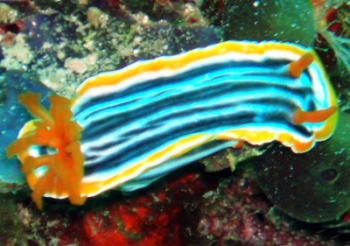
I can't match the pattern on this Chromodoris to any specific species. Can you help me out?
Locality: Lobster Wall - Mabul, 55 feet, Sabah, Malaysia, Sulu Sea, 2 November 2005, Reef wall. Length: 3 cm. Photographer: Mike Krampf.
Thanks,
Mike
mtkrampf@yahoo.com
Krampf, Mike, 2006 (Jul 26) Chromodoris ? - Mabul, Malaysia. [Message in] Sea Slug Forum. Australian Museum, Sydney. Available from http://www.seaslugforum.net/find/16829Dear Mike,|
I used to be puzzled by these multistriped animals but I am pretty sure this is a colour form of Chromodoris magnifica.
Best wishes,
Bill Rudman
Chromodoris magnifica from Sipadan, Malaysia
July 22, 2006
From: Charles Rowe
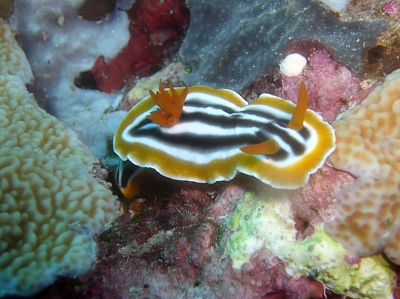
Hi Bill,
Here is another nudi from my trip to Sipadan which I would like you to identify and comment on.
Locality: Sipadan Island, 12 metres, Malaysia, 29 April 2006, reef. Length: 1.5 inches. Photographer: Charles Rowe.
Charles Rowe
bumff@mweb.co.za
Rowe, C., 2006 (Jul 22) Chromodoris magnifica from Sipadan, Malaysia. [Message in] Sea Slug Forum. Australian Museum, Sydney. Available from http://www.seaslugforum.net/find/16851
Dear Charles,
This is Chromodoris magnifica, a quite common, and brilliantly coloured species from the Malay-Indonesian Archipelago. I would dearly love to know what this species feeds on. The evidence at present is somewhat ambiguous. Ironically, both the grey and red sponges in the background of your photo could be its food.
Best wishes,
Bill Rudman
Chromodoris magnifica vs C. magnifa
December 6, 2005
From: Erwin Kodiat
Hi Bill,
According to Helmut Debelius' book, the latin name is Chromodoris magnifa. Which one is correct?
Thanks
Erwin Kodiat
ungu@terong.com
Kodiat, E., 2005 (Dec 6) Chromodoris magnifica vs C. magnifa. [Message in] Sea Slug Forum. Australian Museum, Sydney. Available from http://www.seaslugforum.net/find/15419Dear Erwin,
It's C. magnifica,
Bill Rudman
Chromodoris magnifica colour form
November 3, 2005
From: Wendy Atkinson

Hi Bill
Saw this Chromodoris magnifica at dive site named "Sea Grass" on the east side of Lembeh Strait, North Sulawesi, Indonesia while diving at KBR in May 2005. Depth approximately 40-60 feet. Found with several other nudibranch species eating sponge on bottom side of large rock formations.
Wendy Atkinson
billr@austmus.gov.au
Atkinson, W., 2005 (Nov 3) Chromodoris magnifica colour form. [Message in] Sea Slug Forum. Australian Museum, Sydney. Available from http://www.seaslugforum.net/find/15164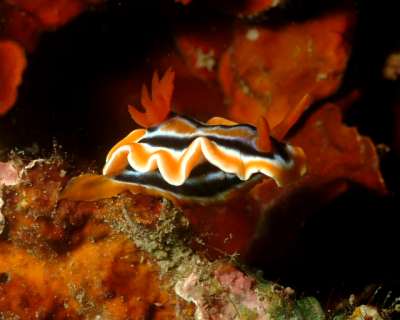
Dear Wendy,
Thanks for this. From the shape of the mantle, and the submarginal orange border I am sure this is C. magnifica. I am beginning to wonder whether the extra orange - in this case the whole of the posterior part of the foot, and the median colour band being orange instead of black - is something to do with the orange sponges this species apparently feeds on.
Best wishes,
Bill Rudman
Chromodoris magnifica from Indonesia
August 11, 2005
From: Marli Wakeling
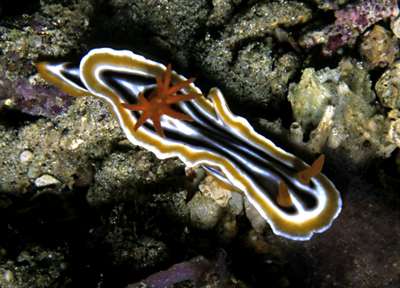
Hi Bill,
This Chromodoris magnifica has an unusual deformation or damage to its mantle. It was found Satonda Island, Nusa Tenggara, Indonesia.
Locality: Magic Rock, Satonda Island, Indonesia, Flores Sea. Depth: 30 feet
Length: 4 cm. 19 July 2005. rubble bottom of broken coral. Photographer: Marli Wakeling
Cheers,
Marli
scubamarli@gmail.com
Wakeling, M., 2005 (Aug 11) Chromodoris magnifica from Indonesia. [Message in] Sea Slug Forum. Australian Museum, Sydney. Available from http://www.seaslugforum.net/find/14520Thanks Marli,
Bill Rudman
Chromodoris magnifica feeding
June 22, 2005
From: Sergey Parinov

Dear Bill,
Here is a Chromodoris magnifica feeding on red sponge. Found at the very edge of the reef facing the flat sandy bottom in Lankayan Island.
Locality: Lankayan Island, north east off the coast of Sabah, Malaysia, Sulu Sea. Depth: 23-25 meters. Length: 3-5 cm. April 2003. edge of the reef close to flat sandy bottom. Photographer: Sergey Parinov
Sergey Parinov
www.sergeyphoto.com/underwater/nudibranchs
webmaster@sergeyphoto.com

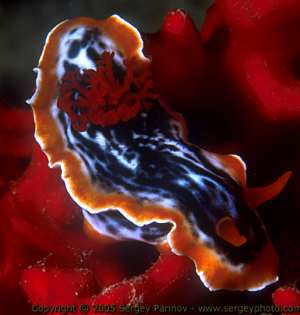

Dear Sergey,
Thanks very much for this. It is another record of the many striped form of this species and is only the second record we have of this species feeding [see #5941]. In you upper photo the buccal bulb can be clearly seen everted onto the sponge.
I will need to check the identification but we seem to be building up evidence for some of these black-lined species feeding on red poecilosclerid sponges.
Best wishes,
Bill Rudman
Colour form of Chromodoris magnifica
September 12, 2003
From: Asther M. Lau

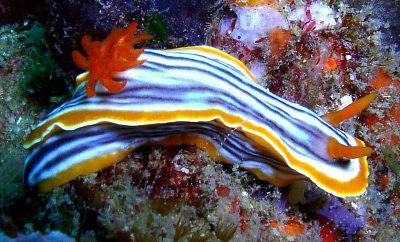
Hello,
Not sure whether these 3 samples are the same type. Do confirm.
All 3 pics are taken by Vivian Koh.
Site: Rajawali Wall, Tenggol Is. Malaysia
Date: 31st May 2003
Depth: 10 to 14 meter
All three were taken from different spots in the dive.
Thank you!
AML
asther@scubadiveknit.com
Lau, A.M., 2003 (Sep 12) Colour form of Chromodoris magnifica. [Message in] Sea Slug Forum. Australian Museum, Sydney. Available from http://www.seaslugforum.net/find/10346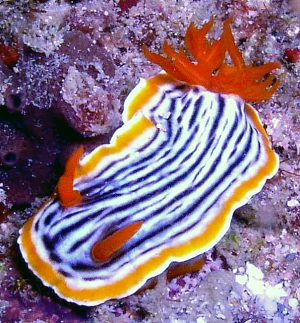
Dear Asther,
As I discussed in an earlier message this animal used to puzzle me, but I am now pretty sure its a colour form of Chromodoris magnifica and seems to be confined to NE tropical Pacific region from Malaysia north.
Best wishes,
Bill Rudman
Chromodoris magnifica from Malaysia
August 1, 2003
From: Carlene Cheong
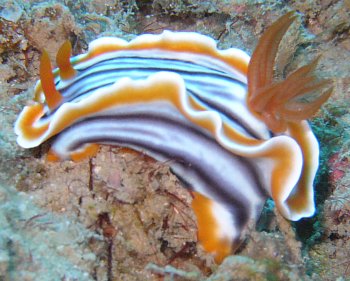
Hi,
Im an avid diver, a baby one infact where I've only started diving last August but hooked on it ever since. Through my dive trips (usually in Malaysia and in Maldives in Jan), I've found myself intrigued by the lil slugs that dot the 'over-dived' reef (especially in Malaysia).
I'm looking forward to more discoveries with you all!
Carlene Cheong
blu_abyss@hotmail.com
Cheong, C., 2003 (Aug 1) Chromodoris magnifica from Malaysia. [Message in] Sea Slug Forum. Australian Museum, Sydney. Available from http://www.seaslugforum.net/find/10026Dear Carlene,
This is a colour form of the chromodorid nudibranch called Chromodoris magnifica. I assume its from Malaysia. Although I like to be able to identify animals for divers on the Forum, one of the 'payments' for this service is some information on where and when the photos were taken. In this way the Forum is building up a valuable collection of observations on where these animals live, what they eat, what their eggs look like, how they vary in colour etc. Much of this information is new, so if you would like to help 'science' while getting names for your interesting 'finds' then I would be glad if you could include some information with your photos.
Best wishes,
Bill Rudman
Can You ID this Sea Slug???
July 12, 2003
From: Brett

Just a few days ago I purchased this sea slug at a local pet store. I had no idea what species of sea slug this was and the store clerk didn't know either. I want to get the ID of this sea slug so I can do more research on it and I can find out what is compatible with it. I don't want to put something into my aquarium that will end up eating this beautiful creature. If you could please just give me the name of this sea slug I will be grateful. The animal usually spends most of its time grazing on algae and moving across my live rock. It is about 1.5" long.
THANKS A BUNCH!!!!
Brett
outlaws24pimp@yahoo.com
Brett, 2003 (Jul 12) Can You ID this Sea Slug???. [Message in] Sea Slug Forum. Australian Museum, Sydney. Available from http://www.seaslugforum.net/find/9935Dear Brett,
This is Chromodoris magnifica. Unfortunately, although it may appear to be grazing on algae, like all its relatives it is a specialised feeder on sponges, so it will gradually starve to death.
Sorry,
Bill Rudman
Chromodoris magnifica with 'satellite dish'
June 24, 2003
From: Ian Dunsmore
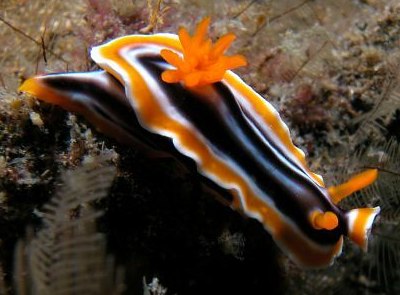
Hi,
I am very new at underwater photography but have been diving since I was a teenager in Scotland back in 1982 and much more frequently now in and around Indonesia for the last five years.
I live and work in Jakarta and was diving in Ahmed, north east Bali on some unexplored sites over a weekend on 30 and 31 May 2003. The attached photos were taken with a Nikoncoolpix5000 digital camera in about 24m on an isolated reef. This is a shore dive, water temp was the usual 28 or 29oC. Viz. was poor for north Bali about 15-20m.
I came across this chromodorid nudibranch which has this unusual cone shaped protrusion in between its rhinophores. It looks a bit like a loudspeaker. Perhaps a new warning device to potential predators. I attach three photos.
Best wishes,
Ian.
sweaty@cbn.net.id
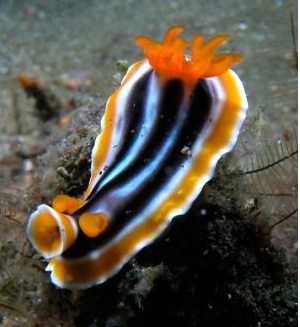

Dear Ian,
This is Chromodoris magnifca with an unusual deformity. What makes it doubly interesting is that we have recently had messages and photos of another chromodorid, Chromodoris kuniei, from Timor, with an almost identical structure which was likened to a satellite dish. I think your 'loudspeaker' or 'foghorn' idea is equally inventive. I have no idea what causes such a deformity. Hopefully it is not a sign of some pollutant in the water.
Best wishes,
Bill Rudman
Chromodoris magnifica with 3 rhinophores
January 30, 2003
From: Gillian Elliott
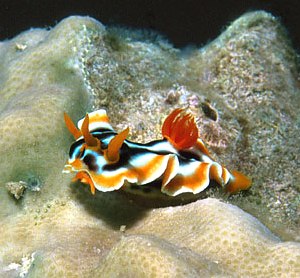
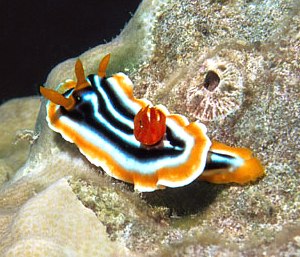
Dear Bill
These photos are of Chromodoris magnifica with three rhinophores - presumably a genetic/developmental defect. Is this common in nudibranchs - this specimen seemed to have no trouble. It is from Mantanani Islands in Sabah, Malaysia
I look foward to your comments
Thanks,
Gillian
gillyelliott@yahoo.com
Elliott, G., 2003 (Jan 30) Chromodoris magnifica with 3 rhinophores. [Message in] Sea Slug Forum. Australian Museum, Sydney. Available from http://www.seaslugforum.net/find/9029Dear Gillian,
Thanks for this photo. I am not sure how common this is, but to try and get some idea on the nature and extent of these abnormalities, I have an Abnormalities Page where such records like yours can be listed. As you will see there at least 3 other species of chromodorid are listed there with 3 rhinophores.
best wishes,
Bill Rudman
How long do Sea slugs live in aquarium?
January 29, 2003
From: Dean Swade
I have had a Chromodoris magnifica for 5+ months now and it seems to be doing well - picks at some of my sponges. What is the life expectancy in a reef tank? I have a 262 gallon with 300lbs of LR
Thanks,
Dean
plum70rt@aol.com
Dear Dean,
In nature, most sea slugs only live a year or less, although there are a few exceptions. I have known aquarium keepers who have kept chromodorids alive for some months, but only by diligently looking after the slug's food sponge, and regularly replacing it when it looked unhealthy. Which is only something you can usually do if you live near the sea where both slug and sponge are found naturally.
So it seems you have been rather fortunate. Either your slug is happy to starve or by chance you have a healthy supply of its food sponge. You say it 'picks at some of my sponges'. Do you mean it is actually feeding on them - leaving a hole or a 'bite mark'? I would love to see a photo if that is possible.
How long will it live? I think you are in unknown territory here. I would say every month more is a bonus
Best wishes,
Bill Rudman
Chromodoris magnifica f rom Malaysia
July 9, 2002
From: Kheong Sann Chan
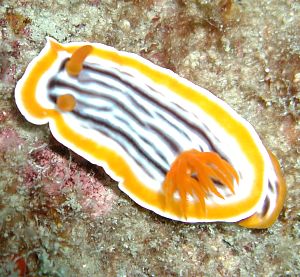
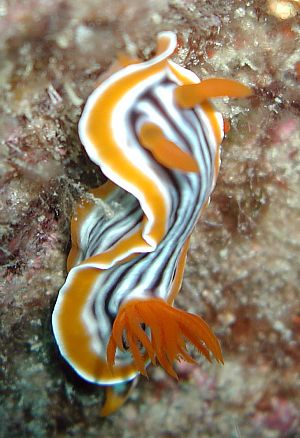
Here are some photos of another nudibranch from Pulau Dayang, off the east coast of west Malaysia. It was about 5cm long.
Location: Dayang, Pinnacles
Date: 8 June, 0800
Depth: 20+m
Kheong
kschan@mail.dsi.nus.edu.sg
Chan, K.S., 2002 (Jul 9) Chromodoris magnifica f rom Malaysia. [Message in] Sea Slug Forum. Australian Museum, Sydney. Available from http://www.seaslugforum.net/find/7210Thanks Kheong,
I am pretty sure this is the same colour form of Chromodoris magnifica as in Sazlina's recent message, also from Malaysia.
Best wishes,
Bill Rudman
Multistriped Chromodoris magnifica?
July 7, 2002
From: Sazlina

Dear Bill,
I found these Chromodoris magnifica mating on the reef of Pulau Pemanggil, Malaysia.
Sazlina
sazlinas@hotmail.com
Sazlina, 2002 (Jul 7) Multistriped Chromodoris magnifica?. [Message in] Sea Slug Forum. Australian Museum, Sydney. Available from http://www.seaslugforum.net/find/6907Dear Sazlina,
The interesting thing about this photo is not that they are mating but that they have so many black stripes. C. magnifica normally has 3 broad black bands. However the submarginal orange border and the secondary branching of some of the gills certainly suggest that this is a colour form of C. magnifica. I have seen similarly coloured animals before from the tropical NW Pacific so it may be a geographic form that occurs in this region.
Thanks
Bill Rudman
Chromodoris magnifica from Bali
March 19, 2002
From: Stuart Hutchison

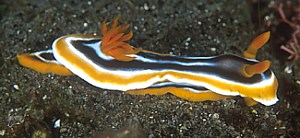
Hi Bill,
Here's Chromodoris magnifica from Bali, Indonesia on 17 Oct 2001. Lengths 40mm. Depth 5m.
Regards,
Stuart
stuart@stuarthutchison.com.au
Hutchison, S., 2002 (Mar 19) Chromodoris magnifica from Bali. [Message in] Sea Slug Forum. Australian Museum, Sydney. Available from http://www.seaslugforum.net/find/6302Thanks Stuart,
Bill Rudman
Colour variation in Chromodoris magnifica
March 13, 2002
From: Bernard Picton
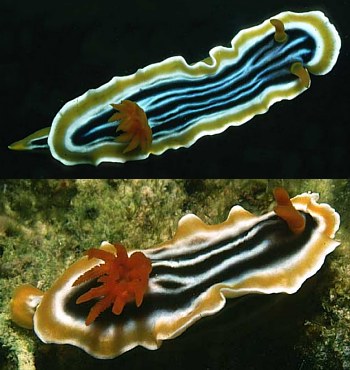
Hi Bill,
I've been looking at the Chromodoris magnifica? which you identified for Lindsay from Hoga Is, Sulawesi on April 8, 1998. I had a couple of photos of the same animal, plus one from the Philippines in 1983 which is a dead-ringer for it. I've sent a couple of scans of typical C. magnifica as well. I am a little suspect of them being the same species, though as you have mentioned elsewhere there do seem to be cases where black lines are being replaced by brown in some individuals.
UPPER RIGHT (TOP) - Bali, March 1989
UPPER RIGHT (BOTTOM) - Mactan Is, Cebu, 27 Mar 1983 - BEPPH49
LOWER LEFT: - Hoga Is., Oct 1997
LOWER RIGHT: - Mactan Is, Cebu, 26 Mar 1983 - BEPPH39
Bernard
bernard.picton.um@nics.gov.uk

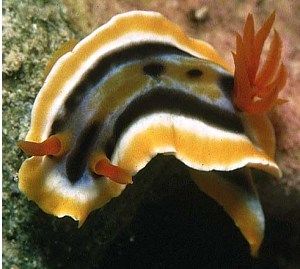
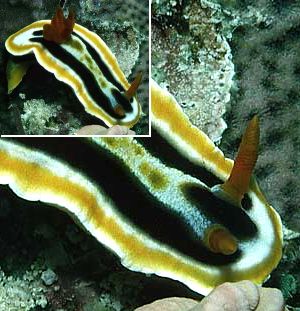
Thanks Bernard,
The bottom two photos do seem a bit of a problem In fact I think the Lower Left animal is probably Chromdoris annae. I have included a magnified copy of the head alomgside and you can see the characteristic punctate blue pattern. However despite a very close look at the lower right photo I can see no similar signs of a punctate pattern in that animal. Perhaps it is C. magnifica and these two colour patterns are a sign of a mimicry complex.
Best wishes,
Bill Rudman
Chromodoris magnifica feeding
January 11, 2002
From: Mike Miller

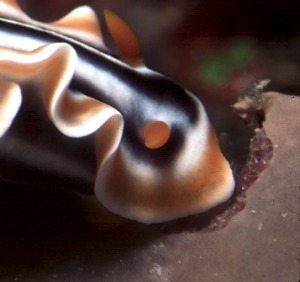
Dear Bill
Here is a pic of Chromodoris magnifica dining on unknown host sponge.
Locale: Batangas, Philippines
Date: April, 1997
Photographer: Michael D. Miller
Enjoy:
Mike Miller
mdmiller@cts.com
Miller, MD. , 2002 (Jan 11) Chromodoris magnifica feeding. [Message in] Sea Slug Forum. Australian Museum, Sydney. Available from http://www.seaslugforum.net/find/5941Thanks Mike,
Definitely seems to having a good feed
Best wishes,
Bill Rudman
Chromodoris magnifica - behavioural studies
February 24, 2000
From: Angela Garton
I am a second year BSc student of the Animal Behaviour and Welfare degree in England. I am currently working on the behaviour and aposematic colouration of Nudbranchia, particularly Chromodoris magnifica. I am looking for tables of statisitical information regarding this subject.
Thankyou for your time.
Angela Garton.
University College Chester.
u83136866@chester.ac.uk
Garton, A., 2000 (Feb 24) Chromodoris magnifica - behavioural studies. [Message in] Sea Slug Forum. Australian Museum, Sydney. Available from http://www.seaslugforum.net/find/1944Dear Angela,
I wish I could help you on the subject but I am afraid there have been no large scale statistical studies on any chromodorid to my knowledge. This is a major impediment to studies on their aposematic mimicry. Unlike butterflies which are amenable to tagging and capture/recapture experiments, nudibranchs are not. I discuss some of these practical problems in a review paper (Rudman, 1991) which might be of interest to you.
Also have a look at the Colour and Defence Page which has a section on aposematism.
Best wishes,
Bill Rudman.
Rudman, W.B. (1991) Purpose in Pattern: the evolution of colour in chromodorid nudibranchs. Journal of Molluscan Studies, 57, (T.E. Thompson Memorial Issue): 5-21.
Rudman, W.B., 2000 (Feb 24). Comment on Chromodoris magnifica - behavioural studies by Angela Garton. [Message in] Sea Slug Forum. Australian Museum, Sydney. Available from http://www.seaslugforum.net/find/1944Chromodoris magnifica from Philippines
November 10, 1999
From: Erwin Koehler

Bill,
To Valda's Chr. africana - here is a Chr. magnifica (without a beauty
spot) and the extra bit at the right side...This one is from the Philippines, Cebu Is., Moalboal housereef, date March 01, 1999, size 3cm, depth 9 m.
Erwin
Medslugs.Koehler@t-online.de
Koehler, E., 1999 (Nov 10) Chromodoris magnifica from Philippines. [Message in] Sea Slug Forum. Australian Museum, Sydney. Available from http://www.seaslugforum.net/find/1508Chromodoris magnifica? from Philippines
October 7, 1999
From: Erwin Koehler

Bill,
This one is from the Philippines, Negros Oriental, Sibulan housereef, depth 10 m, April 1994 by Fred Vogt.
Is it a colour variant of Chr. magnifica or something else?
Erwin
Medslugs.Koehler@t-online.de
Koehler, E., 1999 (Oct 7) Chromodoris magnifica? from Philippines. [Message in] Sea Slug Forum. Australian Museum, Sydney. Available from http://www.seaslugforum.net/find/1406Dear Erwin,
I think its a colour form of C. magnifica. The submarginal orange border seems to be a distinctive feature.
Bill Rudman.
Chromodoris magnifica? from Philippines
July 27, 1999
From: Erwin Koehler

Dear Bill,
here is one more photo from the Philippines, Apo Is., divesite "Cogon", March 1999, 8m depth, size 26 mm.
Is this pale one a Chromodoris magnifica?
Thanks
Erwin.
Medslugs.Koehler@t-online.de
Koehler, E., 1999 (Jul 27) Chromodoris magnifica? from Philippines. [Message in] Sea Slug Forum. Australian Museum, Sydney. Available from http://www.seaslugforum.net/find/1116Dear Erwin,
Yes I think you are right. Although the central area is very blue for this species, the traces of a submarginal orange line, are a good sign that it is C. magnifica.
Best wishes,
Bill Rudman.
Chromodoris magnifica from Papua New Guinea
July 4, 1999
From: Grey McNeil
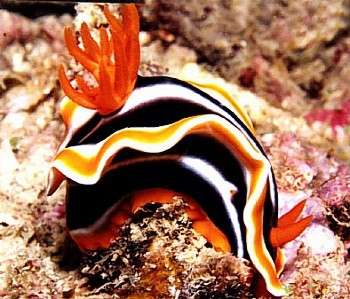
Dear Bill,
Could you identify this photo please. The details are:
LION ISLAND, BOOTLESS BAY, Papua New Guinea, 15m, January 1999, 5cm long.
Thanks,
Grey McNeil.
GREYMACIND@bigpond.com
Dear Grey,
This is Chromodoris magnifica, one of the spectacular white and black lined chromodorids. It was originally collected by Quoy and Gaimard in Papua New Guinea during the great French exploring expedition of Dumont d`Urville in the Astrolabe between 1826-1829.
Bill Rudman.
Rudman, W.B., 1999 (Jul 4). Comment on Chromodoris magnifica from Papua New Guinea by Grey McNeil. [Message in] Sea Slug Forum. Australian Museum, Sydney. Available from http://www.seaslugforum.net/find/996Chromodoris magnifica
June 23, 1999
From: Nerida Wilson

Dear Bill,
Here is another of the chromodorids I have found in my research. It is from Hazard bay, Orpheus Island, Queensland.
Nerida.
nwilson@zoology.uq.edu.au
Wilson, N., 1999 (Jun 23) Chromodoris magnifica. [Message in] Sea Slug Forum. Australian Museum, Sydney. Available from http://www.seaslugforum.net/find/966Dear Nerida,
This is Chromodoris magnifica. It is good to get some more locality records for this species.
Best wishes,
Bill Rudman.
Chromodoris magnifica from W. Australia
April 26, 1999
From: Clay Bryce.
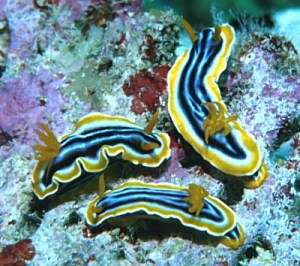
Dear Bill,
Here is C. magnifica from Seringapatam Reef. It is quite common on the oceanic atolls off the Kimberley coast - Scott, Ashmore, Hibernia and Seringapatam Reefs as well as Cartier I. [North western Australia]
Clay Bryce.
W.A. Museum.
Perth.
brycec@museum.wa.gov.au
Bryce, C., 1999 (Apr 26) Chromodoris magnifica from W. Australia. [Message in] Sea Slug Forum. Australian Museum, Sydney. Available from http://www.seaslugforum.net/find/805Thanks Clay,
Bill Rudman.
Chromodoris magnifica from Philippines
January 16, 1999
From: Erwin Koehler

Here is Chromodoris magnifica (Quoy & Gaimard, 1832), Cabilao Is., Philippines, Nov. 1998.
Erwin
E.Koehler@deutschepost.de
Koehler, E., 1999 (Jan 16) Chromodoris magnifica from Philippines. [Message in] Sea Slug Forum. Australian Museum, Sydney. Available from http://www.seaslugforum.net/find/477Erwin,
I think this is the first specimen I have seen from the Philippines.
Bill Rudman.
Chromodoris magnifica
September 10, 1998
From: Aloysia Murni Shintosari

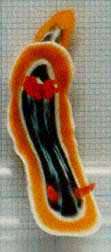
I think they belong to Chromodoris magnifica, because of the white line pattern on the black surface on the notum and white band at the edge of the notum that encircilng the orange band.
They are from the reef at Penjaliran Barat Island, Thousand Islands, Indonesia.
Thankyou for any advice
Aloysia
Aloysia Murni Shintosari
Museum Zoologicum Bogoriense
Cibinong, Indonesia.
mzb@indo.net.id
Aloysia Murni Shintosari, 1998 (Sep 10) Chromodoris magnifica. [Message in] Sea Slug Forum. Australian Museum, Sydney. Available from http://www.seaslugforum.net/find/233Dear Aloysia,
Your identification is correct .. Bill Rudman.
Found in Indonesia
April 8, 1998
From: Lindsay Warren
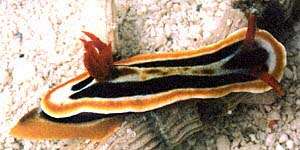
Dear Bill
I have attached a jpg file which I hope you can identify. As with the others they were found around Pulau Hoga in the Tukang Besi islands of SE Sulawesi, Indonesia last September when Bernard Picton was also there. Most of the diving was on walls as previously described heavily covered in hard and soft corals, ascidians, coralline algae and small areas of green / brown algae with depths between 3-20m. Unfortunately I do not have the notes of exactly what surface they were each found on.Many thanks for your help
All the best
Lindsay Warren
100014.2112@compuserve.com
Warren, L., 1998 (Apr 8) Found in Indonesia. [Message in] Sea Slug Forum. Australian Museum, Sydney. Available from http://www.seaslugforum.net/find/45This is almost certainly Chromodoris magnifica. It is another of the black-lined chromodorids and is fairly easily distinguished from the others by its submarginal orange band around the mantle. Unlike Chromodoris dianae which has only just been named, Chromodoris magnifica was collected in New Guinea by Quoy & Gaimard during the French circumglobal Voyage of the Astrolabe under Dumont d'Urville (1826-1829), one of the first great European exploring expeditions...Bill Rudman
Rudman, W.B., 1998 (Apr 8). Comment on Found in Indonesia by Lindsay Warren. [Message in] Sea Slug Forum. Australian Museum, Sydney. Available from http://www.seaslugforum.net/find/45